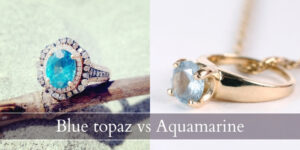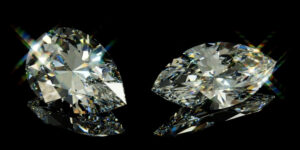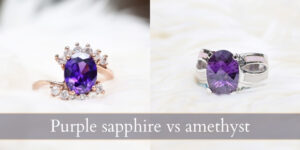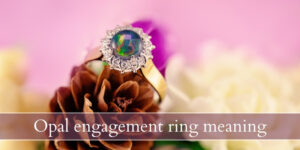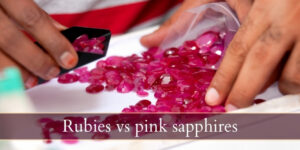Morganite and diamond are two very, very common gemstones in engagement rings, as both have their beauty and unique style. One is more romantic and feminine, while the other dazzles and is absolutely amazing no matter which way you look at it. So you’re bound to make a great decision no matter which one you choose. Let’s compare diamonds and morganite, and see how they fare.
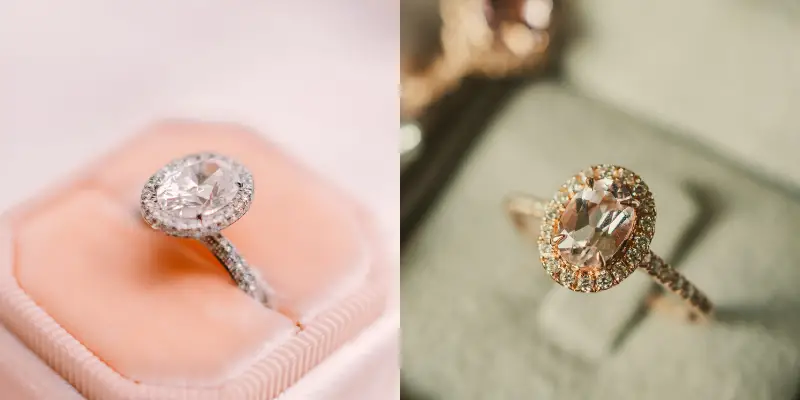
Morganite vs diamond
Morganite has a clear, pale peachy pink color while diamonds are clear, and while morganite doesn’t sparkle at all diamonds are the best at it. There is no resale value in morganite, but diamonds can be sold for up to 50% of their initial value, if you ever find yourself in that situation. Diamonds also last longer in a ring than morganite, since they are much tougher and will not chip or scratch. That being said, morganite is far more affordable then diamonds, so if you’re working on a budget it’s a better option.
What is morganite ?
Morganite is a type of beryl, the same family that brought you emeralds and aquamarines. Morganite is exceptionally clear, and it has a beautiful, soft peachy-pink color bought on by trace amounts of manganese. The color can be very pale or very mild, and it can’t ever get such a strong color as a pink sapphire or a ruby, and this is mostly due to its exceptional clarity. if you look at an aquamarine, you’ll notice that it, too, can only show very light shades of teal or icy blue, again due to its high clarity.
Now, morganite has been around for quite some time and has only entered the spotlight in the past few decades. But since 2010 or so, morganite is a very popular engagement ring center stone, and it’s been very much loved since.
What is diamond ?
Diamonds are the crystallized form of carbon, and are usually sold as clear or with a very fain yellow tint. That yellow tint is the result of tiny, tiny amounts of nitrogen, and the more nitrogen there is in a diamond the stronger the yellow color. No diamond has a complete lack of nitrogen, just a very small amount, so no diamond will ever be 100% colorless. The colorless range starts with the letter D and not A precisely because there are no diamonds that have A-C colorless grade.
Back to diamonds, these have been the go-to engagement ring stones for a couple of centuries, and they have become the traditonal stone to propose with. You can always get something completely different, which is why we’re assuming you’re here. So let’s compare the new favorite morganite with the classic diamond, see how they fare.
Read also: Diamond VS Moissanite
Diamonds have resale value, morganite does not
If you are ever in the position to sell your jewelry, or want to pass down your jewelry to your children, know that diamonds do have resale value. Depending on the jeweler or pawn shop it can be anywhere from 25%-50% of its original value. So if your diamond was worth $5,000 when it was first bought, it can later be sold at anywhere between $1,250-2,500 if it ever need to be sold.
On the other hand, morganite doesn’t have resale value. This is mostly due to its original lower value (about $300 per carat) and the fact that it is, well, not a diamond. Diamonds are in high demand and are likely to still be in high demand for a very long time. Any other gemstone will be less valuable, even in time.
So if a financial safety net is something you want to keep in mind, diamonds are a much safer bet for the future than morganite.
Morganite has a delicate, light color while diamonds are clear
Color can be very important for jewelry, since it dictates a lot from the setting metal to the accent stones and the overall theme of the jewelry piece. So morganite has a very soft, beautiful, and feminine peachy-pink color. Sometimes it can lean more pink, even slightly purple, and sometimes it can lean more orange. The ideal morganite has a balanced peach-pink/salmon so take a very good look at your morganite.
Remember that morganite is a very soft-colored stone, meaning you won’t find one that is a bright, intense peachy-pink. Most of them will be medium toned at best, and many can be very pale.
Diamonds on the other hand are supposed to be as pale and clear as possible. The warmer the diamond the less valuable, but a tiny bit of warmth (like a G-H) can really make the ring take on a vintage, dreamy look. So where a morganite should be as intensely colored as possible, you want diamonds to have as little color as possible.
Read also: Morganite VS Moissanite
Diamonds are much tougher than morganite
Are you planning to wear your jewelry every day ? If it’s a ring or bracelet it’s especially important, since these get a lot of hits and scratches throughout the day. Diamonds hold up far far better than morganite for everyday wear, and this is important if you’re someone who is a bit rough on their jewelry.
Diamonds score a 10 out of 10 on the Mohs hardness scale, so they can’t really get any nicks or cracks from anything other than another diamond (which is extremely rare). Morganite scores an 8 on the same scale, and this means it’s softer than diamonds and may be more easily scratched. This isn’t the worst thing, there are plenty of 8 gems that survive just fine in time. But it’s morganite’s perfect clarity that will reveal any and every tiny scratch that accumulates over time.
If morganite was perfectly polished and clear, in time (if worn every day in a ring or bracelet) it will have tiny scratches, grazes, possible chipping here and there, and it will look very, very dull in time. This means you need to bring the morganite to a jeweler for polishing every once in a while, and in some cases may have to completely replace the stone. Again, how often this happens depends entirely on how often you wear the gem and hoe hard you are on it.
The solution ? Either don’t wear morganite every day, or take it to a jeweler every now and then. Diamonds don’t really have this issue since they can look like brand new even centuries later.
Morganite is much more affordable than diamond
Everyone has a budget, and if you’re like most people (including us), you won’t want to break the bank for your jewelry, even if it’s an engagement ring. So if you’re looking for a more affordable center stone option morganite is absolutely going to be a better match than diamond.
Morganites sell for roughly $300 per carat, while diamonds can be anywhere from $7,000 to $12,000 per carat, depending on cut quality, color, clarity, and shape. Diamonds are also heavier than morganite, and carats measure weight not size. So a 1 carat diamond will look smaller than a 1 carat morganite, since the weight difference can be as much as 30% !
Read also: Rose Cut VS Brilliant Cut
Diamonds sparkle while morganite does not sparkle
Sparkle factor is one of the biggest selling points of diamonds, and for good reasons. Diamonds are dazzling and they put on quite a show, and they make for an impressive ring when you’re flaunting your fresh engagement ring. That sparkle does not go away even years after the wedding, so it makes sense that how much a diamond sparkles is very, very important.
Morganites don’t really sparkle, not like a diamond. They’re not completely dull, of course, but they don’t have the same lightshow. Where a diamond will throw equal amounts of white and rainbow light, a morganite will throw mostly white and no rainbow colors. This is due to a combination of morganite’s:
- lower refractive index (1.7) than diamond (2.42)
- lesser luster (vitreous) than diamond (adamantine)
- stronger body color than diamond
All of these together mean that you won’t get a dazzling sparkle out of morganite, but it also will not be dull. With the right cut shape and style, morganite can still put on a beautiful show. It generally does best when cut into oval, cushion, radiant, princess, and Portuguese cuts, due to the multitude of small facets.
A diamond’s color also affects its sparkle, though not as much as other factors. But we digress, the whiter the diamond the better you will see the sparkle (both white and rainbow light), and the warmer the diamond the harder it will be to see a rainbow sparkle.
Do morganite and diamond go well together ?
Yes, morganite and diamond go very well together in terms of aesthetics. The feminine and soft morganite color pairs well with a lacy, dainty diamond halo, or diamond accent stones. The result is always a beautiful one, especially is set in a warm metal like yellow or rose gold. We think it’d look great in white gold without the rhodium plating too.
The look is great, but while the diamond will hold up for decades without issue, the morganite will accumulate scratches if it’s worn just as often as the diamond.
Party pooper, we know, but we don’t recommend wearing morganite daily unless you’d fine with re-polishing it every few years and/or completely replacing the stone sometimes.

I’m the main author for jewelrymaterialguide.com. I started this site after we did tons of research before our wedding and noticed that there is information about rings, jewelry, and so on that is really hard to find on the internet.

